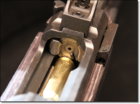So I was taking a closer look at my new rifle which finally I picked up yesterday. The action is the Defiance Deviant Elite. This action/bolt doesn't have a 'conventional' ejector pin. (Correct terminology?) I'm wondering about two things.
1. A classic sign of over-pressure is an imprint on the case head from the ejector pin. This bolt/action has a recess rather than pin on the bolt face. (The spent case is extracted rearward towards a fixed pin at the rear of the action. The recess allows the bolt to pass over the pin which kicks the case out.) So what to look for? Brass flowing into the recess?
2. I understand that typically the ejector pin prevents a case with a bumped shoulder from 'sitting sloppy' in the chamber because it is always pushing the case forward such that the case shoulder is up against the chamber and the 1-2 thou headspace sits at the rear. This action/bolt doesn't seem have anything pushing the case shoulder to the chamber. Maybe I'm missing something, but it seems to me that a case will sit sloppy in the chamber (At least to the extent there is slop between the extractor plate and case rim) rather than being pressured forward and aligning the bullet with the lands.
A pic of the Elite bolt nose can be found here:
https://defiancemachine.com/options/
and can be compared with the ejector pin and claw flat bolt nose.
Enlighten me?
1. A classic sign of over-pressure is an imprint on the case head from the ejector pin. This bolt/action has a recess rather than pin on the bolt face. (The spent case is extracted rearward towards a fixed pin at the rear of the action. The recess allows the bolt to pass over the pin which kicks the case out.) So what to look for? Brass flowing into the recess?
2. I understand that typically the ejector pin prevents a case with a bumped shoulder from 'sitting sloppy' in the chamber because it is always pushing the case forward such that the case shoulder is up against the chamber and the 1-2 thou headspace sits at the rear. This action/bolt doesn't seem have anything pushing the case shoulder to the chamber. Maybe I'm missing something, but it seems to me that a case will sit sloppy in the chamber (At least to the extent there is slop between the extractor plate and case rim) rather than being pressured forward and aligning the bullet with the lands.
A pic of the Elite bolt nose can be found here:
https://defiancemachine.com/options/
and can be compared with the ejector pin and claw flat bolt nose.
Enlighten me?














